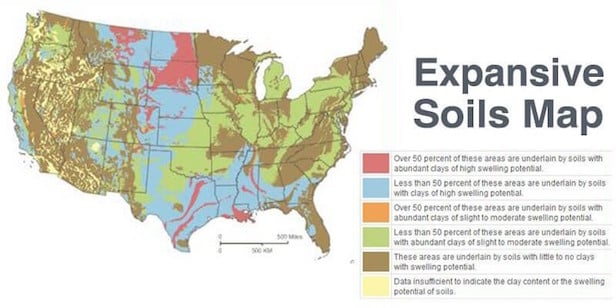 Matthew Marcus, PE, RG
Matthew Marcus, PE, RG
Expansive clay soil is the most predominant geologic hazard across the United States. Each year billions of dollars in damage to building foundations and structures is caused by the shrinking and swelling behavior caused by clay soil. The building distress can manifest in something as easy to address as popped up sidewalk trip hazards, or sticking doors and windows, and can be as major as cracked walls and roofs, and structures that need to be repaired for safety.
- Most highly expansive clays form in residual soil environments spanning from Colorado to Florida, although some are present in the glacial deposits of the interior upper Midwest, and in the marine/lacustrine/paralic deposits of the West Coast, Gulf Coast, Atlantic coast and Great Lakes (see map).
 Most highly expansive clays form in residual soil environments spanning from Colorado to Florida. Image credit: “Swelling Clays Map of the Conterminous United States” by W. Olive, A. Chleborad, C. Frahme, J. Shlocker, R. Schneider and R. Schuster, published in 1989 as Map I-1940 in the USGS Miscellaneous Investigations Series.
Most highly expansive clays form in residual soil environments spanning from Colorado to Florida. Image credit: “Swelling Clays Map of the Conterminous United States” by W. Olive, A. Chleborad, C. Frahme, J. Shlocker, R. Schneider and R. Schuster, published in 1989 as Map I-1940 in the USGS Miscellaneous Investigations Series.
- In order to cause shrink and swell, the soils must be exposed to changes in moisture condition following construction. For existing structures, moisture control may be a suitable option for remediation and it is a design requirement for new construction.
- Geotechnical solutions to expansive clay soil prior to construction include removal and replacement, capping or burying the expansive material, and treatment with hydrated lime.
- Structural solutions to expansive clay in new construction include upgraded structural slabs (post-tension, waffle, mat) or elevated slabs supported on deep foundations. Their need and the design parameters used in the design are provided by the geotechnical study.
- For an existing structure, a forensic geotechnical study is necessary to identify and quantify damages caused to existing buildings, assign positive causation, and make appropriate recommendations for remediation.
- Solutions to distressed buildings often consist of moisture control measures as the clay will not shrink or swell if the moisture is maintained evenly. In addition, flexible finishes including carpeting or slip sheets, drywall installed with gaps between roof and floor, and other measures to accommodate some seasonal fluctuations can help to reduce the frequency of nuisance damage repairs.
- In extreme cases, helical anchors and slab (mud) jacking or even removal and reworking of soil below an existing structure is completed though these measures can be disruptive to tenants and are expensive. In pavement areas, expansive clay soils can be remediated by thicker sections of asphalt, reinforced concrete pavements, and lime treatment.
Although expansive soil is the most predominant cause of soil related distress, it is not the only cause. A geotechnical engineer must be engaged to evaluate the causation and to recommend the repairs that will be right for you. There are unfortunately many cases of repair contractors improperly diagnosing and treating soil related issues only to have them re-surface shortly after the expensive repair has been completed.

















 Copyright © 2024 ALM Global, LLC. All Rights Reserved.
Copyright © 2024 ALM Global, LLC. All Rights Reserved.